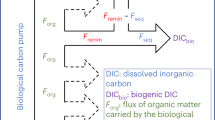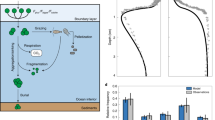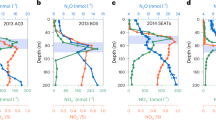Abstract
A perturbation of the carbon cycle and biosphere, linked to globally increased temperatures about 55.9 million years ago, characterized the Palaeocene–Eocene Thermal Maximum. Its effect on global oceanic productivity is controversial. Here we present records of marine barite accumulation rates that show distinct peaks during this time interval, suggesting a general increase in export productivity. We propose that changes in marine ecosystems, resulting from high atmospheric partial pressure of CO2 and ocean acidification, led to enhanced carbon export from the photic zone to depth, thereby increasing the efficiency of the biological pump. Higher seawater temperatures at that time increased bacterial activity and organic matter regeneration. Through this process much of the sinking particulate organic matter was probably converted to dissolved inorganic and organic carbon. We estimate that an annual carbon export flux out of the euphotic zone and into the deep ocean waters could have amounted to about 15 Gt during the Palaeocene–Eocene Thermal Maximum. About 0.4% of this carbon is expected to have entered the refractory dissolved organic pool, where it could be sequestered from the atmosphere for tens of thousands of years. Our estimates are consistent with the amount of carbon redistribution expected for the recovery from the Palaeocene–Eocene Thermal Maximum.
This is a preview of subscription content, access via your institution
Access options
Subscribe to this journal
Receive 12 print issues and online access
$259.00 per year
only $21.58 per issue
Buy this article
- Purchase on Springer Link
- Instant access to full article PDF
Prices may be subject to local taxes which are calculated during checkout



Similar content being viewed by others
References
Dickens, G. R., O’Neil, J. R., Rea, D. K. & Owen, R. M. Dissociation of oceanic methane hydrate as a cause of the carbon isotope excursion at the end of the Paleocene. Paleoceanography 10, 965–971 (1995).
Zachos, J., Pagani, M., Sloan, L., Thomas, E. & Billups, K. Trends, rhythms, and aberrations in global climate 65 Ma to present. Science 292, 686–693 (2001).
McInerney, F. A. & Wing, S. L. The Paleocene–Eocene Thermal Maximum: A perturbation of carbon cycle, climate, and biosphere with implications for the future. Annu. Rev. Earth Planet. Sci. 39, 489–516 (2011).
Pagani, M. et al. Arctic hydrology during global warming at the Palaeocene/Eocene Thermal Maximum. Nature 442, 671–675 (2006).
Panchuk, K., Ridgwell, A. & Kump, L. R. Sedimentary response to Paleocene–Eocene Thermal Maximum carbon release: A model–data comparison. Geology 36, 315–318 (2008).
Zeebe, R. E., Zachos, J. C. & Dickens, G. R. Carbon dioxide forcing alone insufficient to explain Palaeocene–Eocene Thermal Maximum warming. Nature Geosci. 2, 576–580 (2009).
Röhl, U., Westerhold, T., Bralower, T. J. & Zachos, J. C. On the duration of the Paleocene–Eocene Thermal Maximum (PETM). Geochem. Geophys. Geosyst. 8, Q12002 (2007).
Murphy, B. H., Farley, K. A. & Zachos, J. C. An extraterrestrial 3He-based timescale for the Paleocene–Eocene Thermal Maximum (PETM) from Walvis Ridge, IODP site 1266. Geochim. Cosmochim. Acta 74, 5098–5108 (2010).
Zachos, J. C. et al. Rapid acidification of the ocean during the Paleocene–Eocene Thermal Maximum. Science 308, 1611–1615 (2005).
Archer, D., Kheshgi, H. & Maier-Reimer, E. Multiple timescales for neutralization of fossil fuel CO2 . Geophys. Res. Lett. 24, 405–408 (1997).
Bowen, G. J. Up in smoke: A role for organic carbon feedbacks in Paleogene hyperthermals. Glob. Planet. Change 109, 18–29 (2013).
Bowen, G. J. & Zachos, J. C. Rapid carbon sequestration at the termination of the Palaeocene–Eocene Thermal Maximum. Nature Geosci. 3, 866–869 (2010).
Paytan, A. & Griffith, E. M. Marine barite: Recorder of variations in ocean export productivity. Deep-Sea Res. Pt II 54, 687–705 (2007).
Eagle, M., Paytan, A., Arrigo, K. R., van Dijken, G. & Murray, R. W. A comparison between excess barium and barite as indicators of carbon export. Paleoceanography 18, 1060 (2003).
Gattuso, J-P., Bijma, J., Gehlen, M., Riebesell, U. & Turley, C. in Ocean Acidification: Knowns, Unknowns, and Perspectives (eds Gattuso, J. P. & Hansson, L.) 291–311 (Oxford Univ. Press, 2011).
Riebesell, U. et al. Enhanced biological carbon consumption in a high CO2 ocean. Nature 450, 545–548 (2007).
Kroeker, K. J., Kordas, R. L., Crim, R. N. & Singh, G. G. Meta-analysis reveals negative yet variable effects of ocean acidification on marine organisms. Ecol. Lett. 13, 1419–1434 (2010).
Bains, S., Norris, R. D., Corfield, R. M. & Faul, K. L. Termination of global warmth at the Palaeocene/Eocene boundary through productivity feedback. Nature 407, 171–174 (2000).
Torfstein, A., Winckler, G. & Tripati, A. Productivity feedback did not terminate the Paleocene–Eocene Thermal Maximum (PETM). Clim. Past 6, 265–272 (2010).
Bralower, T. J. Evidence of surface water oligotrophy during the Paleocene–Eocene Thermal Maximum: Nannofossil assemblage data from Ocean Drilling Program site 690, Maud Rise, Weddell Sea. Paleoceanography 17, 1023 (2002).
Stoll, H. M., Shimizu, N., Archer, D. & Ziveri, P. Coccolithophore productivity response to greenhouse event of the Paleocene–Eocene Thermal Maximum. Earth Planet. Sci. Lett. 258, 192–206 (2007).
Thomas, E. in Late Paleocene–Early Eocene Biotic and Climatic Events in the Marine and Terrestrial Records (eds Aubry, M-P., Lucas, S. G. & Berggren, W. A.) Biostratigraphy of the late Paleocene benthic foraminiferal extinction. 214–243 (Columbia Univ. Press, 1998).
Sluijs, A. & Brinkhuis, H. A dynamic climate and ecosystem state during the Paleocene–Eocene Thermal Maximum: Inferences from dinoflagellate cyst assemblages on the New Jersey Shelf. Biogeosciences 6, 1755–1781 (2009).
Crouch, E. M. et al. Global dinoflagellate event associated with the late Paleocene Thermal Maximum. Geology 29, 315–318 (2001).
Gibbs, S. J., Bralower, T. J., Bown, P. R., Zachos, J. C. & Bybell, L. M. Shelf and open-ocean calcareous phytoplankton assemblages across the Paleocene–Eocene Thermal Maximum: Implications for global productivity gradients. Geology 34, 233–236 (2006).
Kelly, D. C., Bralower, T. J., Zachos, J. C., Silva, I. P. & Thomas, E. Rapid diversification of planktonic foraminifera in the tropical Pacific (ODP site 865) during the late Paleocene Thermal Maximum. Geology 24, 423–426 (1996).
Thomas, E. Cenozoic mass extinctions in the deep sea: What disturbs the largest habitat on Earth?. Geol. Soc. Am. Spec. Paper 424, 1–23 (2007).
Winguth, A. M. E., Thomas, E. & Winguth, C. Global decline in ocean ventilation, oxygenation, and productivity during the Paleocene–Eocene Thermal Maximum: Implications for the benthic extinction. Geology 40, 63–266 (2012).
Fedorov, A. V., Brierley, C. M. & Emanuel, K. Tropical cyclones and permanent El Niño in the early Pliocene epoch. Nature 463, 1066–1070 (2010).
Kidder, D. L. & Worsley, T. R. Phanerozoic large igneous provinces (LIPs), HEATT (haline euxinic acidic thermal transgression) episodes, and mass extinctions. Palaeogeogr., Palaeoclimatol., Palaeoecol. 295, 162–191 (2010).
Buesseler, K. O. The decoupling of production and particulate export in the surface ocean. Glob. Biogeochem. Cycles 12, 297–310 (1998).
Olivarez Lyle, A. & Lyle, M. W. Missing organic carbon in Eocene marine sediments: Is metabolism the biological feedback that maintains end-member climates?. Paleoceanography 21, PA2007 (2006).
Schneider, B., Engel, A. & Schlitzer, R. Effects of depth and CO2-dependent C:N ratios of particulate organic matter (POM) on the marine carbon cycle. Glob. Biogeochem. Cycles 18, GB2015 (2004).
Liu, J. W., Weinbauer, M. G., Maier, C., Dai, M. H. & Gattuso, J. P. Effect of ocean acidification on microbial diversity and on microbe-driven biogeochemistry and ecosystem functioning. Aquat. Microb. Ecol. 61, 291–305 (2010).
Hoffmann, L. J., Breitbarth, E., Boyd, P. W. & Hunter, K. A. Influence of ocean warming and acidification on trace metal biogeochemistry. Mar. Ecol. Prog. Ser. 470, 191–205 (2012).
Riebesell, U., Körtzinger, A. & Oschlies, A. Sensitivities of marine carbon fluxes to ocean change. Proc. Natl Acad. Sci. USA 106, 20602–20609 (2009).
Passow, U. & Carlson, C. A. The biological pump in a high CO2 world. Mar. Ecol. Prog. Ser. 470, 249–271 (2012).
Riebesell, U. et al. Enhanced biological carbon consumption in a high CO2 ocean. Nature 450, 545–548 (2007).
De Jesus Mendes, P. A. & Thomsen, L. Effects of ocean acidification on the ballast of surface aggregates sinking through the twilight zone. PloS ONE 7, e50865 (2012).
Gibbs, S. J., Stoll, H. M., Bown, P. R. & Bralower, T. J. Ocean acidification and surface water carbonate production across the Paleocene–Eocene Thermal Maximum. Earth Planet. Sci. Lett. 295, 583–592 (2010).
Piontek, J. et al. Effects of rising temperature on the formation and microbial degradation of marine diatom aggregates. Aquat. Microb. Ecol. 54, 305–318 (2009).
Kelly, D. C., Zachos, J. C., Bralower, T. J. & Schellenberg, S. A. Enhanced terrestrial weathering/runoff and surface ocean carbonate production during the recovery stages of the Paleocene–Eocene Thermal Maximum. Paleoceanography 20, PA4023 (2005).
Griffith, E. M. & Paytan, A. Barite in the ocean: Occurrence, geochemistry and palaeoceanographic applications. Sedimentology 59, 1817–1835 (2012).
Falkowski, P. G. et al. The evolution of modern eukaryotic phytoplankton. Science 305, 354–360 (2004).
Dickson, A. J., Cohen, A. S. & Coe, A. L. Seawater oxygenation during the Paleocene–Eocene Thermal Maximum. Geology 40, 639–642 (2012).
Hansell, D. A. Recalcitrant dissolved organic matter fractions. Annu. Rev. Mar. Sci. 5, 421–445 (2013).
Sexton, P. F. et al. Eocene global warming events driven by ventilation of oceanic dissolved organic carbon. Nature 471, 349–352 (2011).
Engel, A. et al. Effects of sea surface warming on the production and composition of dissolved organic matter during phytoplankton blooms: Results from a mesocosm study. J. Plankton Res. 33, 357–372 (2011).
Yamada, N., Tsurushima, N. & Suzumura, M. Effects of CO2-induced seawater acidification on microbial processes involving dissolved organic matter. Energy Procedia 37, 5962–5969 (2013).
Engel, A. et al. CO2 increases 14C-primary production in an Arctic plankton community. Biogeosciences 10, 291–1308 (2013).
Acknowledgements
Samples were provided by the Integrated Ocean Drilling Program. This work was supported by National Science Foundation CAREER grant OCE-0449732 (to A.P.). We thank U. Riebesell and U. Passow for discussion on ocean acidification and the biological pump.
Author information
Authors and Affiliations
Contributions
A.P., Z.M., E.G., E.T. and J.Z. wrote the manuscript. Z.M. and E.G. processed the sediment samples for wt% barite, BARs and export production calculations. E.T., B.M. and J.Z. contributed to the age models used for BAR reconstructions. A.P. conceived and coordinated the work and proposed the data interpretation model.
Corresponding author
Ethics declarations
Competing interests
The authors declare no competing financial interests.
Supplementary information
Supplementary Information
Supplementary Information (PDF 755 kb)
Supplementary Information
Supplementary Information (XLS 96 kb)
Rights and permissions
About this article
Cite this article
Ma, Z., Gray, E., Thomas, E. et al. Carbon sequestration during the Palaeocene–Eocene Thermal Maximum by an efficient biological pump. Nature Geosci 7, 382–388 (2014). https://doi.org/10.1038/ngeo2139
Received:
Accepted:
Published:
Issue Date:
DOI: https://doi.org/10.1038/ngeo2139
This article is cited by
-
Coupled microbial bloom and oxygenation decline recorded by magnetofossils during the Palaeocene–Eocene Thermal Maximum
Nature Communications (2018)
-
Very large release of mostly volcanic carbon during the Palaeocene–Eocene Thermal Maximum
Nature (2017)
-
Earth system feedback statistically extracted from the Indian Ocean deep-sea sediments recording Eocene hyperthermals
Scientific Reports (2017)
-
An abyssal carbonate compensation depth overshoot in the aftermath of the Palaeocene–Eocene Thermal Maximum
Nature Geoscience (2016)



